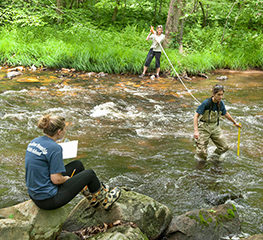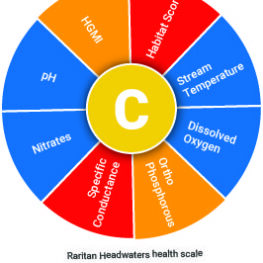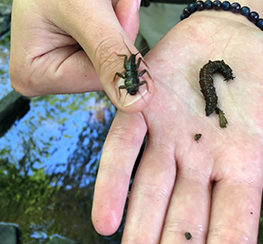How clean is the water in rivers and streams near you?
For the past 30+ years Raritan Headwaters has been on a mission to find out!

Trained volunteers are the core of RHA’s stream monitoring program
Every June, RHA scientists and volunteers visit 70+ sites within the Upper Raritan River Watershed Region to collect data on stream health. Wading into the water with nets, they sample the streams for “benthic macroinvertebrates,” bottom-dwelling insects, worms and snails whose presence is an indicator of clean water. They also assess habitats in and around streams, and test the water’s chemistry.
Click here to look up your watershed address and learn about the health of streams near you.
The information gathered through the award-winning stream monitoring program is used to compile an annual “Report Card” grading each section of stream.
For 2023, the overall water quality grade for RHA’s 470-square-mile region in Hunterdon, Somerset and Morris counties was a “C.” Some of the parameters we study were good (blue on the health scale) while some were not (orange and red on the health scale). This indicates that much improvement is needed in the way our streams are protected. For example, planting trees and shrubs along streams helps by filtering rainwater, stabilizing banks and providing shade to prevent waters from overheating in the summer. Reducing the amount of impervious surfaces like parking lots and pavement also helps; so does installing “green infrastructure” like rain gardens to capture polluted stormwater.

To view RHA’s full 2023 Water Quality Report Card click here.
Here are some of the measurements you’ll see:

Benthic macroinvertebrates like this stonefly and cranefly larvae are used to assess the biological health of streams
The High Gradient Macroinvertebrate Index (HGMI) grades water quality based on the species of benthic macroinvertebrates living in each section of stream. If certain pollution-sensitive macroinvertebrates are absent, the stream is considered impaired. The HGMI is used by the N.J. Department of Environmental Protection and the U.S. Environmental Protection Agency to determine if sites meet state and national water quality standards under the Clean Water Act.
Chemical monitoring tests stream waters for dissolved oxygen, temperature, pH (whether water is acidic or alkaline), turbidity (cloudiness), phosphate, chloride, specific conductance (a measure of dissolved salts), and nitrate.
Habitat assessments include a number of factors, including stream flows, amount of stream banks are erosion, whether there are frequent riffles and rocks in streams, and the conditions on the land surrounding streams.
Many thanks to the 100+ trained “citizen scientists” who volunteer each year to help RHA monitor streams in our watershed!
To learn more about the stream monitoring program, how data is collected, and how water quality scores are calculated, please visit our Surface Water Program page
For more information contact RHA Watershed Scientist, Benjamin Harris at bharris@raritanheadwaters.org
